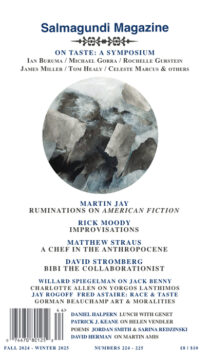Many Authors at Salmagundi:
 ROCHELLE GURSTEIN: In the course of writing my new book (on the ephemeral life of the classic in art), I was heartened to find that a standard of taste could be established when a work of art is felt to exemplify primary aspirations and excellences. Joshua Reynolds set out this understanding in his Discourses on Art (1790) when he located the standard of taste in “the authority and practice of those whose work may be said to have been consecrated by having stood the test of ages.” From the sixteenth century until the nineteenth, ancient sculpture such as the Venus de’ Medici and the Apollo Belvedere, which had been unearthed during the great building projects in Rome during the Renaissance, and also those artists who had most perfectly imitated them—Raphael and Michelangelo—met this test. These “true examples of grandeur,” as Reynolds called them, were regarded as models for artists to imitate and as the indisputable standard of taste. Exemplar and standard were synonymous. And as long as the practice was in good working order and artists and viewers felt part of its intellectual and aesthetic continuum, they could confidently judge works of art, both present and past.
ROCHELLE GURSTEIN: In the course of writing my new book (on the ephemeral life of the classic in art), I was heartened to find that a standard of taste could be established when a work of art is felt to exemplify primary aspirations and excellences. Joshua Reynolds set out this understanding in his Discourses on Art (1790) when he located the standard of taste in “the authority and practice of those whose work may be said to have been consecrated by having stood the test of ages.” From the sixteenth century until the nineteenth, ancient sculpture such as the Venus de’ Medici and the Apollo Belvedere, which had been unearthed during the great building projects in Rome during the Renaissance, and also those artists who had most perfectly imitated them—Raphael and Michelangelo—met this test. These “true examples of grandeur,” as Reynolds called them, were regarded as models for artists to imitate and as the indisputable standard of taste. Exemplar and standard were synonymous. And as long as the practice was in good working order and artists and viewers felt part of its intellectual and aesthetic continuum, they could confidently judge works of art, both present and past.
more here.
Enjoying the content on 3QD? Help keep us going by donating now.
